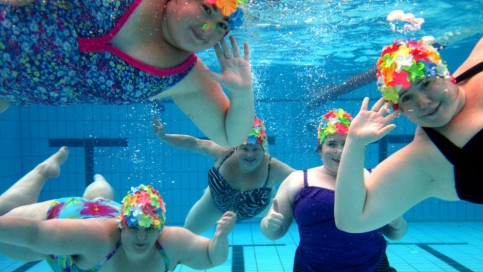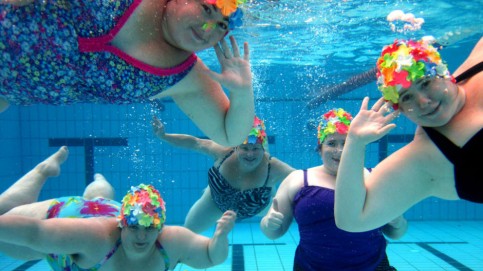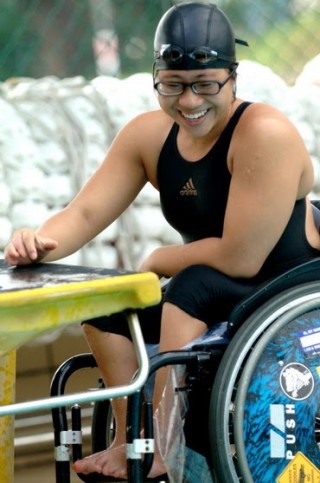Designing Decency: Swimsuits and Bodies in Public Spaces

Aquaporko!, “the story of Melbourne’s fat femme synchronized swim team."
by Lucas Crawford
(Editor’s note: Though it may not be perfect weather for swimming and sunbathing, this is inspired by the Vancouver Maritime Museum’s recent exhibition “Babes and Bathers: History of the Swimsuit” which ran until November 2nd. This may also be inspiring reading for those headed to more tropical places for the holidays, or braving the Polar Bear Swim.)
According to Section 174 of the Criminal Code of Canada, “a person is nude who is so clad as to offend against public decency or order.” In this view, a fashion-irreverent (or is that “irrelevant”?) person like me is often “nude.” In fact, I’m likely “nude” right now!
The ambiguity of the criminal code allows us to ask some big questions about bodies in public spaces, even though BC’s current climate for public nudity is rather warm. Which bodies are entitled to occupy public space, in which outfits, and for which reasons? Why are some bare bodies subject to heightened scrutiny, others to ogling, and still others to punishment?
These questions occurred to me when I visited the Vancouver Maritime Museum’s recent exhibition, “Babes and Bathers: History of the Swimsuit”. As others have described, the show featured 60+ pieces of swimwear, most provided by Ivan Sayers, a local fashion historian. The suits ranged from the relatively reserved wool suits of the 1890s to the somewhat saucy numbers of the later 20th century, including my favourite maroon number:
As for local content, Vancouver brands such as Christopher Ryan featured prominently. Portland’s Jantzen company – which operated a Vancouver factory at Kingsway and East 10th Ave from the mid-20s to the 90s – was also represented. The Museum of Vancouver reports that the wool suits seen below, emblazoned with beaches’ names, were available as early as 1913 and weren’t retired until the 1960s.
Janet Smith suggests in The Georgia Straight that “the evolution of the swimsuit is directly related to the use of decreasing amounts of fabric.” While this is often true, the maroon men’s suit shown above reminds us that this history did not develop so evenly. Imagine the reactions this dated suit would elicit if it were donned at Second Beach pool in 2015! For that matter, compare the classic men’s Speedo to today’s trends of long board-shorts and loose trunks. Spandex – introduced to swimwear by Speedo in the 1970s – is now somewhat of a running cultural joke, permissible only for superheroes. As we’ve loosened men’s suits, perhaps the norms of Canadian masculinity have become tighter.
In a province and country with a legacy of punishing politically motivated nudism – recall that Canada’s 1932 criminalization of nudity was meant to target the Doukhobor people in BC , who were arrested after a nude protest – rethinking ideas about “public decency” is especially important. Much has changed since then; after all, I did walk past a gaggle of nude protestors at the Vancouver Art Gallery last week. However, it still befits us to confront the ways in which judgments about race, size, class, and ability shape our beliefs about which bodies are obscene, which should be covered, and which are entitled to bare (or adorn) skin in public. Perhaps these will spark important conversation regarding cultural norms of “decency” in public spaces.
- Autostraddles’s Swimsuit Issue: Butches, Bois, Femmes, Dykes, Grrrls and Otherwise-Identified Beachgoers
- Burqini Swimwear, producers of swimwear for Muslim women





